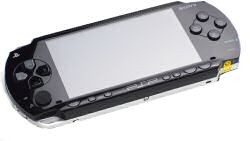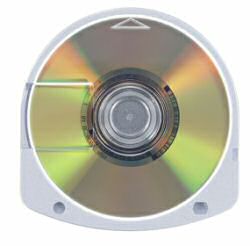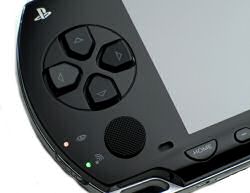Reviews by category
Sony PlayStation Portable (PSP)
Buy Now
Sony Base Pack (white)only £129 from DABs
 Sony PSP base-pack
Sony PSP base-pack£129.99 from Game
 Base Unit Console: Black (PSP)
Base Unit Console: Black (PSP)from £135.99 at Amazon
 SanDisc 2Gbyte
SanDisc 2GbyteMemory Stick ProDuo
for £17.99 from


Sony PlayStation on the move
Is it a games console, a music player or a movie player? Yep - all of these, and probably a whole lot more.
The Sony Play Station Portable (PSP) is quite a remarkable, to the extent that I wasn't even sure how to approach this review. It just does so much that a single article just can't do it justice, and so this is just an introduction. I hope to write separate more in depth reviews over the coming weeks of the various different uses to which this outstanding piece of equipment can be put - and cover also some of the downsides inherent in Sony's paranoia.
You can buy the PSP from Sony in a number of ways - boxed with more or less accompanying products. The 'base-pack' includes just the PSP, power supply, manual and introductory disk. The 'giga-pack' comes with a 1Gbyte memory card (a memory stick Duo) along with headphones, USB cable, pouch and other odds and ends.
I went for the 'base pack' and bought other elements separately: a 2Gbyte memory stick and a hard protective case.
The hardware
From a hardware perspective Sony really has outdone itself with capabilities for this machine, both in terms of the unit itself and how it can connect to other products. A simple overview of the hardware is as follows:
- 480x272 16:9 widescreen TFT LCD display
- Stereo speakers and headphone output
- IEEE 802.11b Wireless Ethernet network (WiFi)
- USB 2.0
- IrDA Infrared remote input/output
- Memory Stick Pro Duo
- UMD disk drive (like a mini DVD) for games and video
Physically the device feels very solid, probably not surpising given what Sony have crammed in, there can't be much room in there!
When you first turn on the PSP you'll immediately be impressed with the quality and resolution of the screen. It's bright, very clear, large and certainly the best I've seen on a small format machine.
So... what does it do?
Well, with that hardware specification you'd expect it to do just about anything bar make the tea. It does - or at least has a good try. The PSP :
- Plays games (it is a games console!)
- Can play multi-player games over the WiFi network with other PSP owners
- Plays videos on Sony's proprietary UMD disk format
- Plays MP3 and other format music files
- Can play video stored on a Memory Stick (more on this later)
- Can connect to the Internet and make use of PodCasts (and more on this later as well!)
Unfortunately Sony has taken it's traditional proprietary approach and make doing anything that doesn't involve revenue for Sony difficult. This is a real pity, because if Sony were just to trust its customers the PSP could be so much more.
So - while the PSP plays video from a UMD disk flawlessly, trying to download and play one of your own DVDs or home-videos is tortuous. It can be done, but it should be easy.
Open versus closed
When Palm launched their ground-breaking Pilot PDA and created a whole new gadget segment a great deal of their success was due to creating what Palm called 'The Palm Economy'. They made the Palm open, allowing the army of software enthusiasts to write applications for the Palm that took it so far beyond the initial product, and in the process creating both a loyal customer base and equally loyal, almost fervent set of developers.
Sony has taken a different approach - keeping the system very much closed. That of course doesn't stop software developers wanting to write their own applications and so an underground 'home brew' community has grown. Half their time is unfortunately and unproductively spent trying to circumvent Sony's attempt to wipe them out. Sony don't want people writing software for their platform unless those people pay Sony a royalty for the privilege. To so do, software authors must actively break into the Sony software in order to persuade the hardware to run their software. Each time they do Sony release a newer version of their software that plugs the gap.
Is this justified? Well - depends on your viewpoint:
How I imagine Sony see the world: You have to sell consoles by the boat-load. If you can't then game developers aren't going to invest the significant resource to make games that work on that console. Problem - things like the PSP are expensive to produce. You have the up-front research and developments costs, and then you have the manufacturing costs for the unit itself. In the case of the PSP both of these must be significant and Sony is likely selling at a loss.
Sony needs to generate other profitable revenue to make it worth investing in things like the PSP. It doesn't make money on the console, so it makes it elsewhere. The elsewhere is a levy, or license fee paid by game developers for each game sold. This is much like printer manufactuers almost giving printers away and making a killing on proprietary ink cartridges.
If anyone can write software for a console and avoid paying Sony royalties, then what incentive has Sony for developing the PSP2? Well - none. Sony Shareholders aren't going to see a loss making games console as a great return on investment.
The other viewpoint. The PSP is a neat piece of hardware. It's a challenge to make my software work on it. Sony is abusing a dominant position by restricting my access the their hardware. I'm completely justified in making every effort to break their operating system so my software runs.
Both these viewpoints have some value. What would happen if Sony sold the PSP at £300 instead of about £150 and made their money on the console. Anyone could write software for it, just as you do on your PC. Would you be prepared to pay £300 for a PSP console that would run anyones software? Would you really?

UMD disks
UMD stands for "Universal Media Disk". One supposes the Universal in this context refers to the fact it can store games, audio and video, not that it can be played on lots of devices, much like a DVD. They can only be played on the PSP (small Universe!).
UMD disks are a (yet another) new proprietary Sony format. The disks are basically like mini DVDs, about 3-4cm across. I believe they can hold just under 2Gbytes of data, and so are more dense than standard DVD formats. Despite being proprietary I do think Sony have come up with a good design. The disks themselves are held in a protective plastic cover. I seem to spend half my life picking up DVDs discarded by my daughters and trying, to no avail, to explain why the disks mustn't be scratched. Sony have cracked this for very many cases, making a DVD like format much more robust in smaller hands!
UMD disks are used both to hold games and movies. I haven't yet bought a UMD movie. I think Sony have made a mistake with the movies. Generally these movies have been retailing at a premium to standard DVD formats despite : only being playable in a PSP; the lower quality inherent in a small screen device.
Controls during game play
I've tried a couple of games on the PSP. The first being Pirates of the Caribbean and the other Ridge Racer Platinum. The former being a good adventure/action/fight game and the latter being a driving game. I might review the games separately if I get a chance. For now I'll give some feedback on the controls and how easy I found the console in operation.

For anyone familiar with the PS2, the controls will come as no surprise. On the right-hand side are a groups of four controls labeled triangle, circle, X, and square. On the right you have four arrow/direction keys. You also have an 'analogue' control stick, which at first sight looks a little like a microphone until you move it. The little black pad has a movement probably 1cm left-right and up-down. Movement in a game generally depends on how far you push this pad. In Ridge Racer for example this is used as the steering wheel. The further you push it the harder you turn the wheel. This can't of course substitute for a real steering wheel, but it does work and is much more practical on the move!
My one comment on the analogue stick is that I personally find it's position too low-down so that I find it quite a strain to use for very long. Other users may of course have a different view.
Holding the PSP between two hands leaves your index fingers ideally positioned for the last two controls the 'left' and 'right' buttons.
Connecting to other devices
Sony provide both USB, WiFi (wireless) and infra-red (IrDa) interfaces for connecting with other devices. In theory there should be absolutely no reason why you should not use either USB or WiFi for any allowed purpose. Unfortunately Sony do not agree!
If you plug your PSP into your computer with a USB cable it appears as a new hard-disk on your computer, just like a USB memory stick. You can copy music files across directly to your PSP, although you have to make sure you copy them to the right directories.
Connecting to a WiFi network should be the same. It isn't! Sony has decided that the USB is used for some things and Wifi for others. So if you want to copy files to the PSP then you use USB. This is a real pain and resulted in a concerted hunt for an appropriate USB cable. Luckily I had one stuffed at the back of a draw.
Accessing the web?
Sony's view of Wifi is to connect to other PSPs and to the Internet. My PSP had the version 2.6 software installed. I've since upgraded to 2.8 (some home brewers would suggest this is a mistake).
My house has a nice WiFi network connecting all the computers together along with connecting them to the Internet. For security reasons I have all WiFi access encrypted using WEP. The PSP connected with no problems. The version 2.8 software comes with two main Internet functions : web-browser and RSS (Really Simple Syndication).
Web-browser. It's not as straightforward to use as Internet Explorer or Firefox, because there is no keyboard. That said the controls are pretty straightforward. Obviously sites tend of look a little odd given the restricted screen size, but they are actually remarkably usable.
RSS : The most popular use for RSS is to distribute news/articles. A more recent use has been to distribute audio and video files (commonly known as 'podcasts'). The PSP only supports this more recent interpretation. For example if you try to access the GadgetSpeak RSS feed you're told that "the data type is not supported" (doesn't support HTML - hmmmmmmm).
I tried the PodCast model by visiting the BBC web-site. I managed quite successfully to subscribe to both audio and video PodCasts. The PSP treats the RSS content differently depending on whether it is audo or video:
Audio : the PSP 'streams' audio feeds, meaning that it starts playing the audio straight away and downloads as it plays. This means you get almost instantaneous content.
Video : if you access a video RSS feed (for example the BBC Newsnight programme) the entire file must first be downloaded to a memory card - which means it must fit on your memory card! Apart from the memory issue, this also means you have a significant delay between requesting content and then actually seeing anything. Tea anyone?
This is of course completely the wrong way round - video should definitely be streamed! Hopefully this is something Sony will address in the next software release for the PSP.
You have content?
I have all of my CDs copied to various computers around the house. I've paid for them all, I don't believe in not doing that, having them on the computer means I can find music quickly and play it on any computer in the house.
One of the first things I wasted half a day doing with my PSP was working out how to get it to access my music library over it's WiFi connection. Basically I couldn't work out how!
The PSP hardware is very capable of doing this - but Sony don't want me to do that. They want me to buy more hardware from them in the form of a 'LocationFree Player'. As far as I can work out this is a simple box that can 'beam' content from another source across WiFi to a recipient device.
My PC can do that - does that right now. I don't need more hardware for that.
In the Sony world though you do. This is probably the area in which I feel most strongly that Sony is treating it's customers badly. They are not selling me something that does something not done by something else - they want to sell me something I already have - and at a significant cost (£229!!! More than my PSP cost!). No Sony - this really is where I draw the line!
Playing your own videos
Sony's preferred route for playing video on the PSP is for you to buy UMD disks. They like that route because they make a profit on each disk they sell. I have no problem with that at all, as I said above I'd rather pay £150 for my PSP and pay a royalty on games and UMD disks. Problem is a) I already have lots of DVDs that I've already bought that I'd like to watch and b) There is no reason for UMD disks to cost more even given Sony's royalty.
So...... Can I play my DVDs on my PSP?
YES
But..... it's not easy. I'll write another article on how to do this and hopefully remove some of the dead-ends I followed!
Overall impressions
I've not come across a product for which I have more mixed feeling. I love the PSP hardware and what the magicians at Sony have managed to engineer into such a small package.
I hate the unnecessary restrictions Sony place on what could be done with this hardware. Yes - make your royalty on games and UMD disks, but don't prevent me using content I already own. Make UMD videos competitive. They can only be played on a PSP - why are these more expensive than a DVD that I can play on any DVD equipment? No reason.
I can't help thinking that this is an absolutely fantastic piece of hardware.... hampered by software restrictions and corporate paranoia. It could do so much and can do so much. It just can't do a lot of it easily! In the product scoring the only thing I've marked down is 'ease of use', and that's personal - I want to copy my DVDs to my PSP for when I'm out. Sony make that difficult. I want to stream music I already have from my computer to my PSP over WiFi - Sony make that difficult.
If you want an absolutely fantastic portable games machine - buy one. Hell - buy one anyway. Despite the restrictions and almost childish approach Sony has taken to making things difficult, this is such a cool product! Also, once you've got one, you'll be able to do all the things Sony doesn't want you to, it's just a little hard.
To Sony? Guys, you have created a hardware platform to die for - loosen the reigns a little and let it fly, let it reach its full potential!
I put together my PSP system from Game. The base pack is now available for £129 and the price of a 2G memory stick has just dropped to £17.99. The price of the Giga-pack with 1G memory stick is around £269, although that comes with a case and a couple of games. My preference was to have the lower price and buy a few pre-owned games and a hard case.
| add to del.icio.us | Digg this review |
| StumbleUpon | |













 !!
!!













Comment by jasonappah, 20 May 2008 20:10